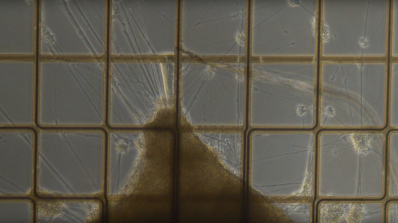Alvin Lucier was an American experimental composer whose compositions were arguably as much science experiments as they were music. The piece he is best known for, I Am Sitting in a Room, explored the acoustics of a room and what happens when you amplify the characteristics that are imparted on sound in that space by repeatedly recording and playing back the sound from one tape machine to another. Other works have employed galvanic skin response sensors, electromagnetically activated piano strings and other components that are not conventionally used in music composition.
Undoubtedly the most unconventional thing he’s done (so far) is to perform in an exhibit at The Art Gallery of Western Australia in Perth which opened earlier this month. That in itself would not be so unconventional if it weren’t for the fact that he passed away in 2021. Let us explain.
While he was still alive, Lucier entered into a collaboration with a team of artists and biologists to create an exhibit that would push art, science and our notions of what it means to live beyond one’s death into new ground.
The resulting exhibit, titled Revivication, is a room filled with gong-like cymbals being played via actuators by Lucier’s brain…sort of. It is a brain organoid, a bundle of neurons derived from a sample of his blood which had been induced into pluripotent stem cells. The organoid sits on a mesh of electrodes, providing an interface for triggering the cymbals.

“But the organoid isn’t aware of what’s happening, it’s not performing” we hear you say. While it is true that the bundle of neurons isn’t likely to have intuited hundreds of years of music theory or its subversion by experimental methodology, it is part of a feedback loop that potentially allows it to “perceive” in some way the result of its “actions”.
Microphones mounted at each cymbal feed electrical stimulus back to the organoid, presumably providing it with something to respond to. Whether it does so in any meaningful way is hard to say.
The exhibit asks us to think about where creativity comes from. Is it innate? Is it “in our blood” so to speak? Do we have agency or are we being conducted? Can we live on beyond our own deaths through some creative act? What, if anything, do brain organoids experience?
This makes us think about some of the interesting mind-controlled musical interfaces we’ve seen, the promise of pluripotent stem cell research, and of course those brain computer interfaces. Oh, and there was that time the Hackaday Podcast featured Alvin Lucier’s I Am Sitting in a Room on What’s that Sound.















Long live Alvin Lucier. Hopefully his mastery of chaotic acoustics goes for many years.
goes? you mean echoes?
Interesting, question, strange, frightening to some maybe, but undoubtedly a big step forward for the autonomous systems to keep organoïds and cell cultures alive.
I know lot of cells react to red light. I wonder if one (very patient) hacker could gently blink a red light to the exposed brain when, say, two gongs play one after the other, and thus teach this dead artists cells to play a chord when illuminated in red light…
Well, don’t use a laser pointer, one don’t want to fry that poor thing, but to try to train it or play with it.
Also, I wonder what happend when the nutriments are low?
Did they simulate the feeding during the day, with nutriments low and high, and sleep periods? Or did they just set a constant nutriment level?
Lastly, how do they simulate/replace the immune system?
As clean as this contraption may be, it will be visited by a lot of people, and thus it’s dangerous for such a fragile organism?
Again, I don’t want to harm that poor thing, I’m just wondering how they solved these problems.
I enjoyed that he was behind the idea and a part of its design, that makes it so great! Also nice how the video explains the emergent behaviour very good, being honest about how it works and it’s unique properties and limitations.
Being honest that I was not aware of his work or passing, it was worth to learn about him here. Thanks for that Seth!
The maestro is decomposing.
They’re decomposing composers.
There’s nothing much anyone can do.
You can still hear Beethoven,
But Beethoven cannot hear you.
I was hoping I’d see this reference.
Tangential note: Zombie brain feedback composer was not on my bingo card for this year
This is like an echo of Henrietta Lacks (a sample of her cancerous cells – taken without her consent – are still replicating and used for various experiments and discoveries).
It’s a grown organoid, so to say it’s him is specious. It fits with artistry but it’s completely disjoint from his own mind which is no in his grave.
“Revivification, or, I Have No Mouth And I Must Scream”
“ah sweet. man-made horrors beyond my comprehension”
Why not put the neurons behind a computer screen and train them to do work by rewarding them with a something and slowly decrease it over ti…. oh
This is like confusing a CPU with the operating system that could run on it. The organoid could have been formed by cells from anything with a nervous system.
They really missed an opportunity to call this work “I am sitting in a tomb”
And the forthcoming sequel (let me thaw out this sample…), “I am sitting in a womb”.
The should record it and release a record called Alvin Lucier Dead in Concert